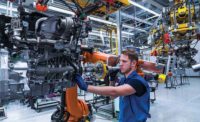Robots are used in many large hospitals to deliver supplies and assist doctors with delicate surgical procedures. In the future, robotic surgery will become the routine rather than the exception.
Some of those tools of tomorrow are being developed today at Vanderbilt University’s Medical Engineering and Discovery Lab (MED). It is one of several labs within the Vanderbilt Institute in Surgery and Engineering, an interdisciplinary R&D initiative.
“We are a part of the mechanical engineering department, but we also work closely with physicians at the Vanderbilt Medical Center,” says Robert Webster, an associate professor of mechanical engineering who serves as director of MED.
“The lab is a place where doctors and engineers work side by side to create new lifesaving medical technologies,” adds Webster. “We design and construct devices to make interventional medicine more accurate, less invasive and more effective. Robots have a great deal of potential in making surgery better, so a relatively large percentage of our projects are [focused in that area].
“With a world-class medical center a five-minute walk from the lab, we are often in operating rooms observing surgical procedures and conducting experiments with the devices we build,” Webster points out. “We also patent our work, which enables us to transfer it to commercial products, amplifying its real-world impact.”
MED projects in the past have focused on gastrointestinal surgery, interventional pulmonology, neurosurgery, otolaryngology and urologic surgery. “We also remain on the lookout for new clinical challenges within the body where we can improve the standard of care using engineering,” says Webster, who established the lab in 2008.
Current projects include a surgical robot with tentacle-like, needle-diameter arms that removes tumors from the center of the head through the nose; a parallel robot that reduces invasiveness in cochlear implant surgery, which restores hearing to the deaf; and robotic systems to improve lung and prostate surgery.
“We often combine medical images, mechanics-based models, and advanced sensors and actuators to help doctors treat their patients more effectively,” explains Webster.
“Graduate and undergraduate students in the MED lab receive a unique educational experience in which they work side by side with surgeons,” adds Webster. “They are encouraged to pursue not only ongoing lab projects, but also their own ideas as they learn to be innovators in surgical engineering and robotics.”
A surgical robot with a tiny mechanical wrist developed by Webster and his colleagues was recently cited by The Wall Street Journal as one of six “emerging technologies that could have a big impact on new medicine in coming years”
The robot consists of an arm made of tiny concentric tubes that become smaller as they extend out, similar to a radio antenna, with a mechanical wrist at the end. The wrist is less than 0.0625-inch thick and can bend up to 90 degrees.
“The new device is designed to provide needlescopic tools with a degree of dexterity that they have previously lacked,” claims Webster. “[This will] allow surgeon-operators to perform a number of procedures, such as precise resections and suturing, that haven’t been possible before. It will also allow the use of needles in places that have been beyond their reach, such as the nose, throat, ears and brain.
“We work hard to bridge the traditional ‘valley of death’ between academic benchtop research and widely distributed devices that help a lot of patients,” says Webster. “Accomplishing this requires working with industry partners to commercialize our research.
MED partners with a variety of startup companies, such as Acoustic MedSystems Inc. and Pathfinger Therapeutics Inc. But, it also works with larger firms, such as Intuitive Surgical Inc. and MathWorks Inc.
"We take a patient and surgical problem-centric approach, so we'll build anything that's needed to get the job done," notes Webster. "In determining whether to take on a new project, we look first at the potential clinical impact and second at what particular type of engineering or technology is required.
"Over the next year of two, we plan to introduce courses that will integrate medical students and engineering students on problem-focused teams to innovate [and create new types of] interventional devices and processes," adds Webster.







